Virtual Reality Education: An IT Artefact for Disabled Students
VerifiedAdded on 2023/01/03
|7
|1885
|74
Project
AI Summary
This project proposes the development of an IT artefact: a virtual reality (VR) based educational system designed to provide accessible and engaging learning experiences, particularly for individuals with disabilities. The system aims to create a fully immersive online educational environment, including virtual classrooms, laboratories, and social spaces, accessible through VR headsets. Students, teachers, and administrators can interact within this virtual campus, participating in classes, conducting experiments, and engaging in social activities. The VR environment offers advantages like hands-on learning, eliminating physical limitations for disabled students, and fostering a more inclusive learning environment. The project highlights the potential of VR to enhance learning outcomes, improve student engagement, and provide a safe and personalized educational experience. The artefact's evaluation would involve assessing its usability, accessibility, and effectiveness in achieving the project's aims and objectives, potentially through user testing and expert review.
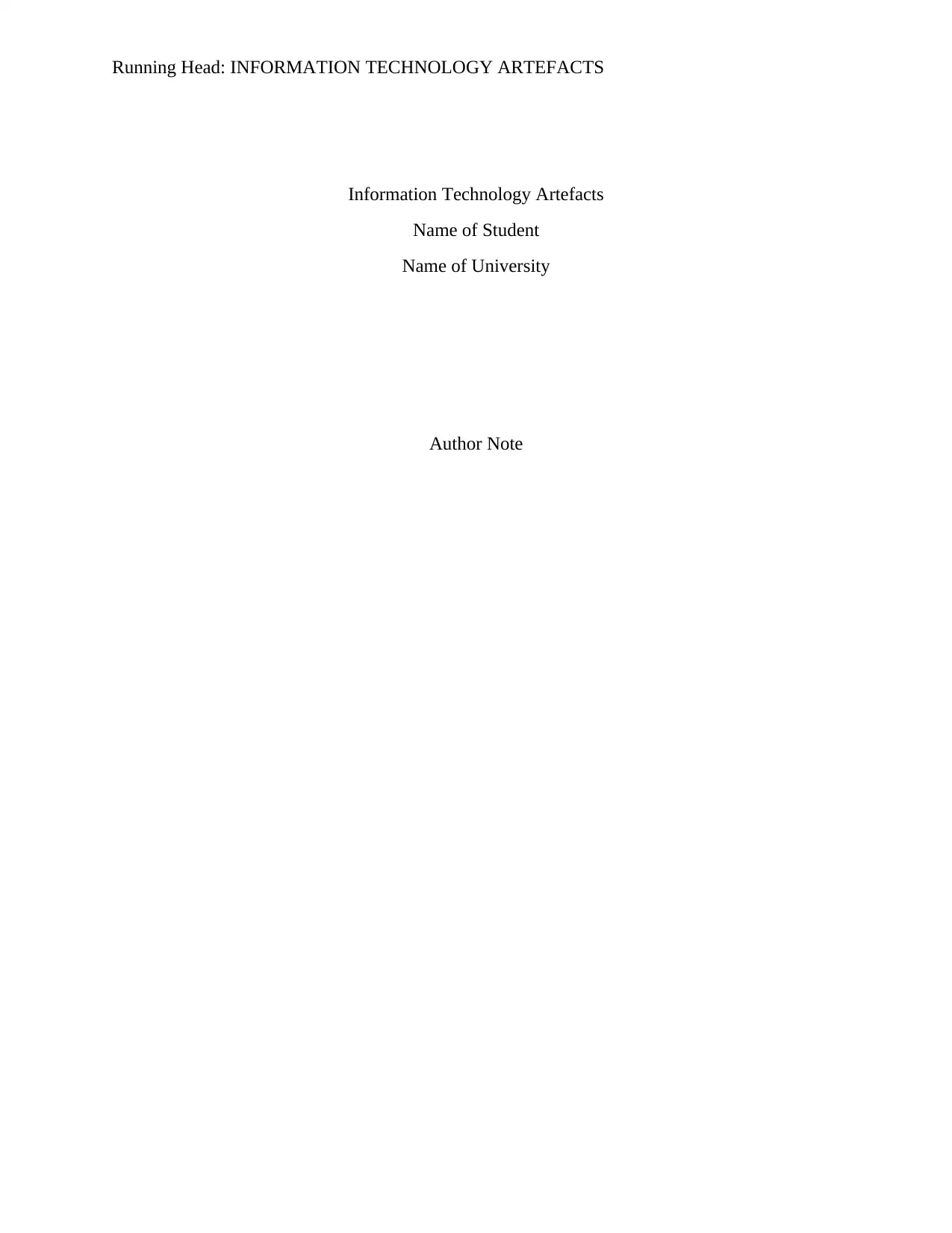
Running Head: INFORMATION TECHNOLOGY ARTEFACTS
Information Technology Artefacts
Name of Student
Name of University
Author Note
Information Technology Artefacts
Name of Student
Name of University
Author Note
Paraphrase This Document
Need a fresh take? Get an instant paraphrase of this document with our AI Paraphraser
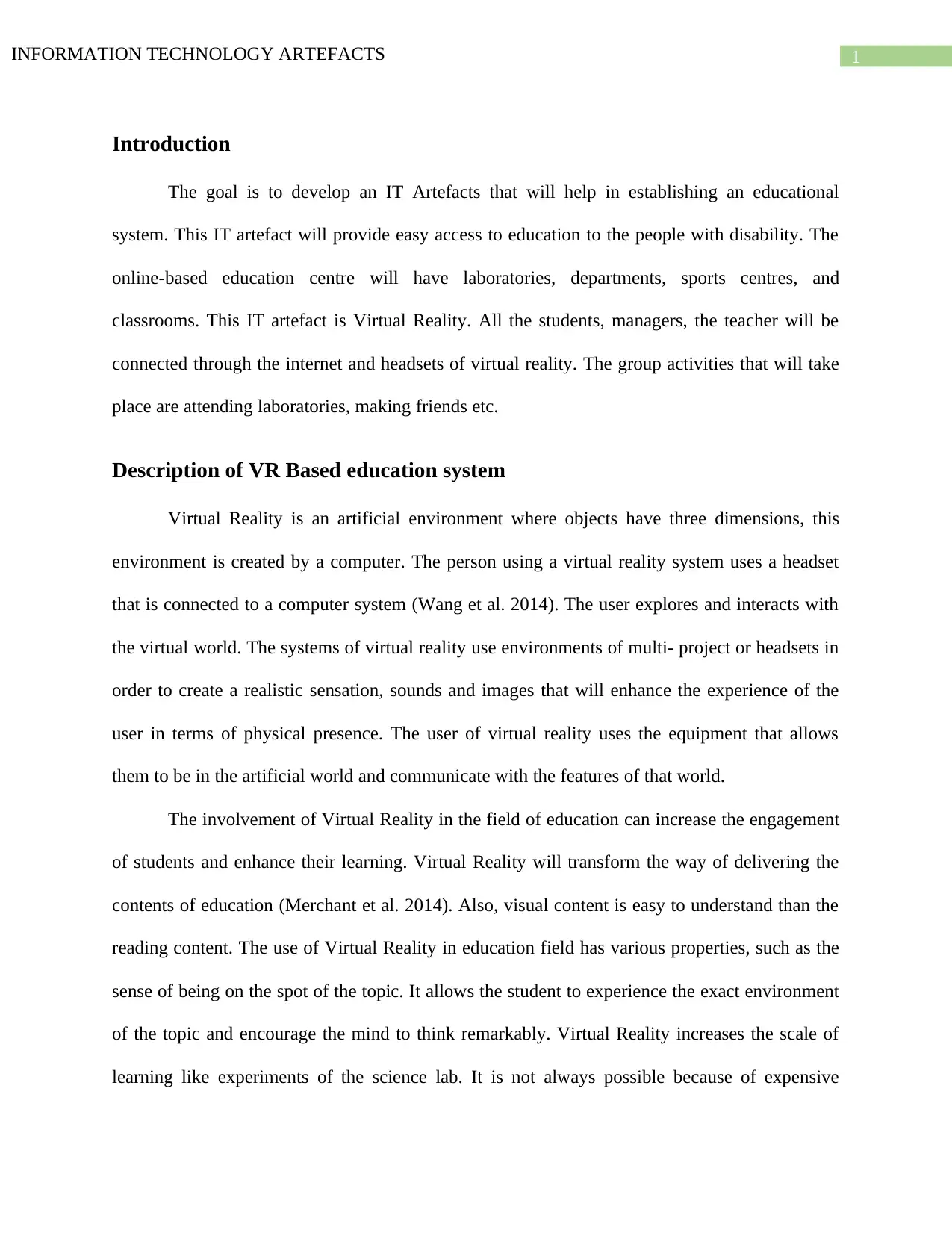
1INFORMATION TECHNOLOGY ARTEFACTS
Introduction
The goal is to develop an IT Artefacts that will help in establishing an educational
system. This IT artefact will provide easy access to education to the people with disability. The
online-based education centre will have laboratories, departments, sports centres, and
classrooms. This IT artefact is Virtual Reality. All the students, managers, the teacher will be
connected through the internet and headsets of virtual reality. The group activities that will take
place are attending laboratories, making friends etc.
Description of VR Based education system
Virtual Reality is an artificial environment where objects have three dimensions, this
environment is created by a computer. The person using a virtual reality system uses a headset
that is connected to a computer system (Wang et al. 2014). The user explores and interacts with
the virtual world. The systems of virtual reality use environments of multi- project or headsets in
order to create a realistic sensation, sounds and images that will enhance the experience of the
user in terms of physical presence. The user of virtual reality uses the equipment that allows
them to be in the artificial world and communicate with the features of that world.
The involvement of Virtual Reality in the field of education can increase the engagement
of students and enhance their learning. Virtual Reality will transform the way of delivering the
contents of education (Merchant et al. 2014). Also, visual content is easy to understand than the
reading content. The use of Virtual Reality in education field has various properties, such as the
sense of being on the spot of the topic. It allows the student to experience the exact environment
of the topic and encourage the mind to think remarkably. Virtual Reality increases the scale of
learning like experiments of the science lab. It is not always possible because of expensive
Introduction
The goal is to develop an IT Artefacts that will help in establishing an educational
system. This IT artefact will provide easy access to education to the people with disability. The
online-based education centre will have laboratories, departments, sports centres, and
classrooms. This IT artefact is Virtual Reality. All the students, managers, the teacher will be
connected through the internet and headsets of virtual reality. The group activities that will take
place are attending laboratories, making friends etc.
Description of VR Based education system
Virtual Reality is an artificial environment where objects have three dimensions, this
environment is created by a computer. The person using a virtual reality system uses a headset
that is connected to a computer system (Wang et al. 2014). The user explores and interacts with
the virtual world. The systems of virtual reality use environments of multi- project or headsets in
order to create a realistic sensation, sounds and images that will enhance the experience of the
user in terms of physical presence. The user of virtual reality uses the equipment that allows
them to be in the artificial world and communicate with the features of that world.
The involvement of Virtual Reality in the field of education can increase the engagement
of students and enhance their learning. Virtual Reality will transform the way of delivering the
contents of education (Merchant et al. 2014). Also, visual content is easy to understand than the
reading content. The use of Virtual Reality in education field has various properties, such as the
sense of being on the spot of the topic. It allows the student to experience the exact environment
of the topic and encourage the mind to think remarkably. Virtual Reality increases the scale of
learning like experiments of the science lab. It is not always possible because of expensive
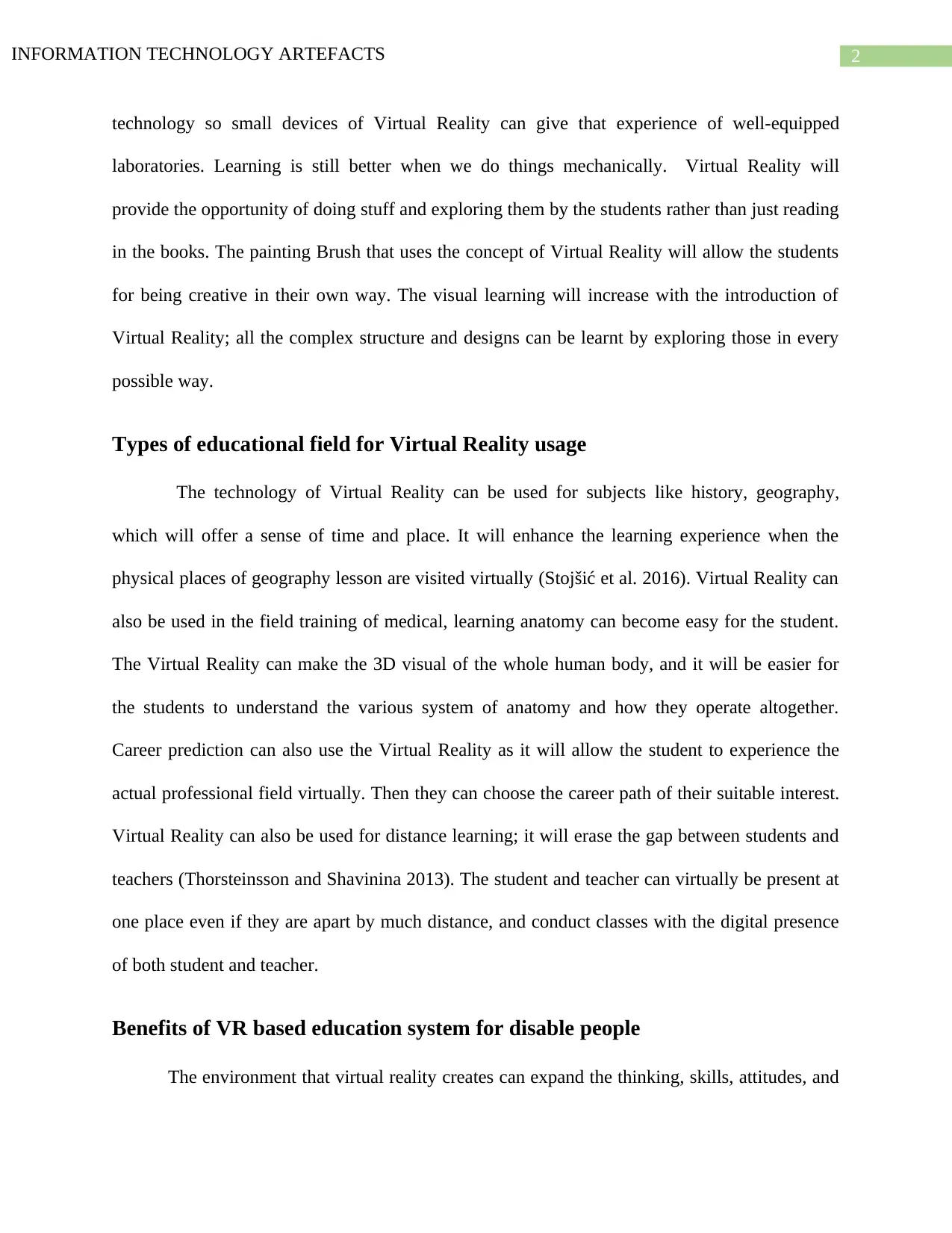
2INFORMATION TECHNOLOGY ARTEFACTS
technology so small devices of Virtual Reality can give that experience of well-equipped
laboratories. Learning is still better when we do things mechanically. Virtual Reality will
provide the opportunity of doing stuff and exploring them by the students rather than just reading
in the books. The painting Brush that uses the concept of Virtual Reality will allow the students
for being creative in their own way. The visual learning will increase with the introduction of
Virtual Reality; all the complex structure and designs can be learnt by exploring those in every
possible way.
Types of educational field for Virtual Reality usage
The technology of Virtual Reality can be used for subjects like history, geography,
which will offer a sense of time and place. It will enhance the learning experience when the
physical places of geography lesson are visited virtually (Stojšić et al. 2016). Virtual Reality can
also be used in the field training of medical, learning anatomy can become easy for the student.
The Virtual Reality can make the 3D visual of the whole human body, and it will be easier for
the students to understand the various system of anatomy and how they operate altogether.
Career prediction can also use the Virtual Reality as it will allow the student to experience the
actual professional field virtually. Then they can choose the career path of their suitable interest.
Virtual Reality can also be used for distance learning; it will erase the gap between students and
teachers (Thorsteinsson and Shavinina 2013). The student and teacher can virtually be present at
one place even if they are apart by much distance, and conduct classes with the digital presence
of both student and teacher.
Benefits of VR based education system for disable people
The environment that virtual reality creates can expand the thinking, skills, attitudes, and
technology so small devices of Virtual Reality can give that experience of well-equipped
laboratories. Learning is still better when we do things mechanically. Virtual Reality will
provide the opportunity of doing stuff and exploring them by the students rather than just reading
in the books. The painting Brush that uses the concept of Virtual Reality will allow the students
for being creative in their own way. The visual learning will increase with the introduction of
Virtual Reality; all the complex structure and designs can be learnt by exploring those in every
possible way.
Types of educational field for Virtual Reality usage
The technology of Virtual Reality can be used for subjects like history, geography,
which will offer a sense of time and place. It will enhance the learning experience when the
physical places of geography lesson are visited virtually (Stojšić et al. 2016). Virtual Reality can
also be used in the field training of medical, learning anatomy can become easy for the student.
The Virtual Reality can make the 3D visual of the whole human body, and it will be easier for
the students to understand the various system of anatomy and how they operate altogether.
Career prediction can also use the Virtual Reality as it will allow the student to experience the
actual professional field virtually. Then they can choose the career path of their suitable interest.
Virtual Reality can also be used for distance learning; it will erase the gap between students and
teachers (Thorsteinsson and Shavinina 2013). The student and teacher can virtually be present at
one place even if they are apart by much distance, and conduct classes with the digital presence
of both student and teacher.
Benefits of VR based education system for disable people
The environment that virtual reality creates can expand the thinking, skills, attitudes, and
⊘ This is a preview!⊘
Do you want full access?
Subscribe today to unlock all pages.

Trusted by 1+ million students worldwide
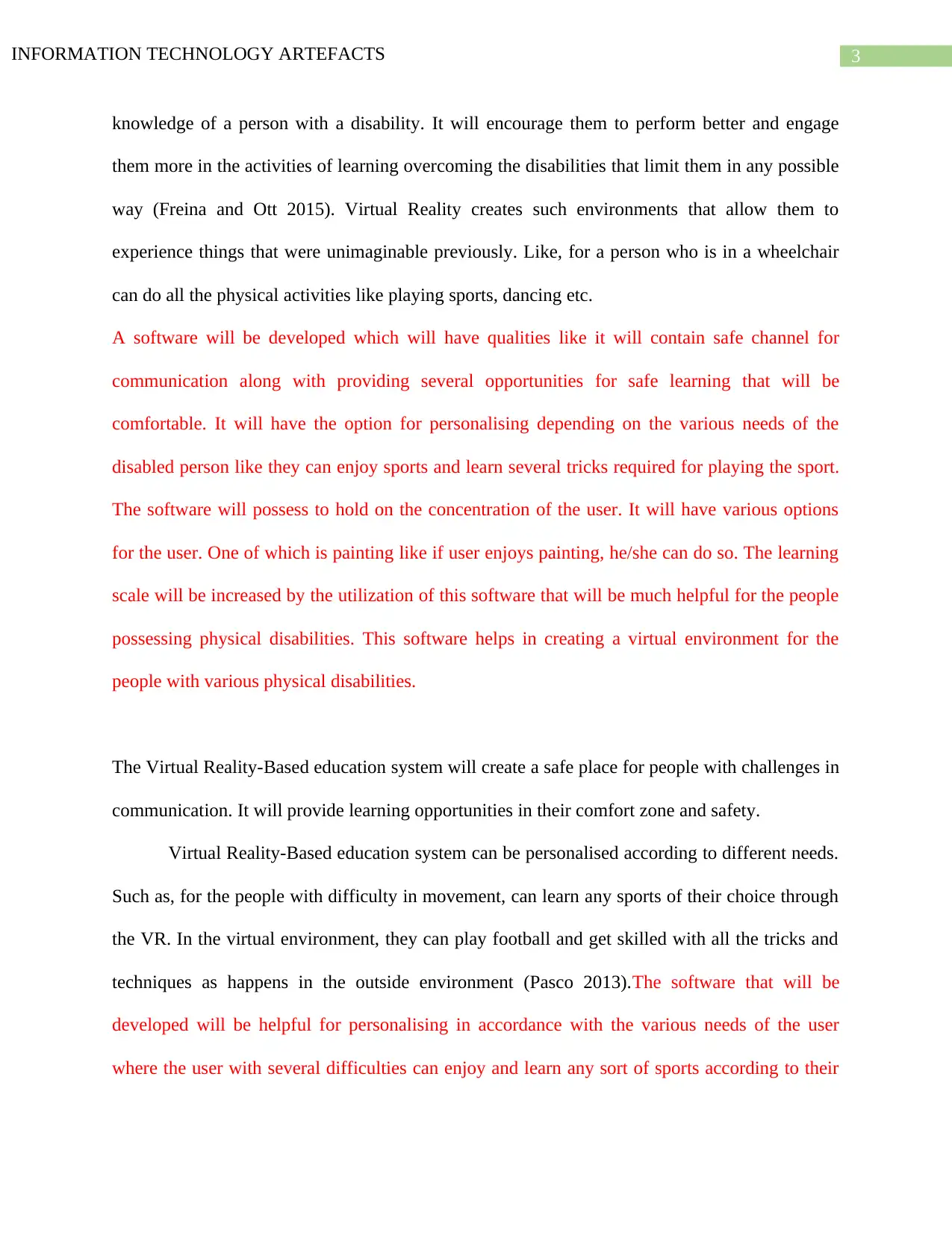
3INFORMATION TECHNOLOGY ARTEFACTS
knowledge of a person with a disability. It will encourage them to perform better and engage
them more in the activities of learning overcoming the disabilities that limit them in any possible
way (Freina and Ott 2015). Virtual Reality creates such environments that allow them to
experience things that were unimaginable previously. Like, for a person who is in a wheelchair
can do all the physical activities like playing sports, dancing etc.
A software will be developed which will have qualities like it will contain safe channel for
communication along with providing several opportunities for safe learning that will be
comfortable. It will have the option for personalising depending on the various needs of the
disabled person like they can enjoy sports and learn several tricks required for playing the sport.
The software will possess to hold on the concentration of the user. It will have various options
for the user. One of which is painting like if user enjoys painting, he/she can do so. The learning
scale will be increased by the utilization of this software that will be much helpful for the people
possessing physical disabilities. This software helps in creating a virtual environment for the
people with various physical disabilities.
The Virtual Reality-Based education system will create a safe place for people with challenges in
communication. It will provide learning opportunities in their comfort zone and safety.
Virtual Reality-Based education system can be personalised according to different needs.
Such as, for the people with difficulty in movement, can learn any sports of their choice through
the VR. In the virtual environment, they can play football and get skilled with all the tricks and
techniques as happens in the outside environment (Pasco 2013).The software that will be
developed will be helpful for personalising in accordance with the various needs of the user
where the user with several difficulties can enjoy and learn any sort of sports according to their
knowledge of a person with a disability. It will encourage them to perform better and engage
them more in the activities of learning overcoming the disabilities that limit them in any possible
way (Freina and Ott 2015). Virtual Reality creates such environments that allow them to
experience things that were unimaginable previously. Like, for a person who is in a wheelchair
can do all the physical activities like playing sports, dancing etc.
A software will be developed which will have qualities like it will contain safe channel for
communication along with providing several opportunities for safe learning that will be
comfortable. It will have the option for personalising depending on the various needs of the
disabled person like they can enjoy sports and learn several tricks required for playing the sport.
The software will possess to hold on the concentration of the user. It will have various options
for the user. One of which is painting like if user enjoys painting, he/she can do so. The learning
scale will be increased by the utilization of this software that will be much helpful for the people
possessing physical disabilities. This software helps in creating a virtual environment for the
people with various physical disabilities.
The Virtual Reality-Based education system will create a safe place for people with challenges in
communication. It will provide learning opportunities in their comfort zone and safety.
Virtual Reality-Based education system can be personalised according to different needs.
Such as, for the people with difficulty in movement, can learn any sports of their choice through
the VR. In the virtual environment, they can play football and get skilled with all the tricks and
techniques as happens in the outside environment (Pasco 2013).The software that will be
developed will be helpful for personalising in accordance with the various needs of the user
where the user with several difficulties can enjoy and learn any sort of sports according to their
Paraphrase This Document
Need a fresh take? Get an instant paraphrase of this document with our AI Paraphraser
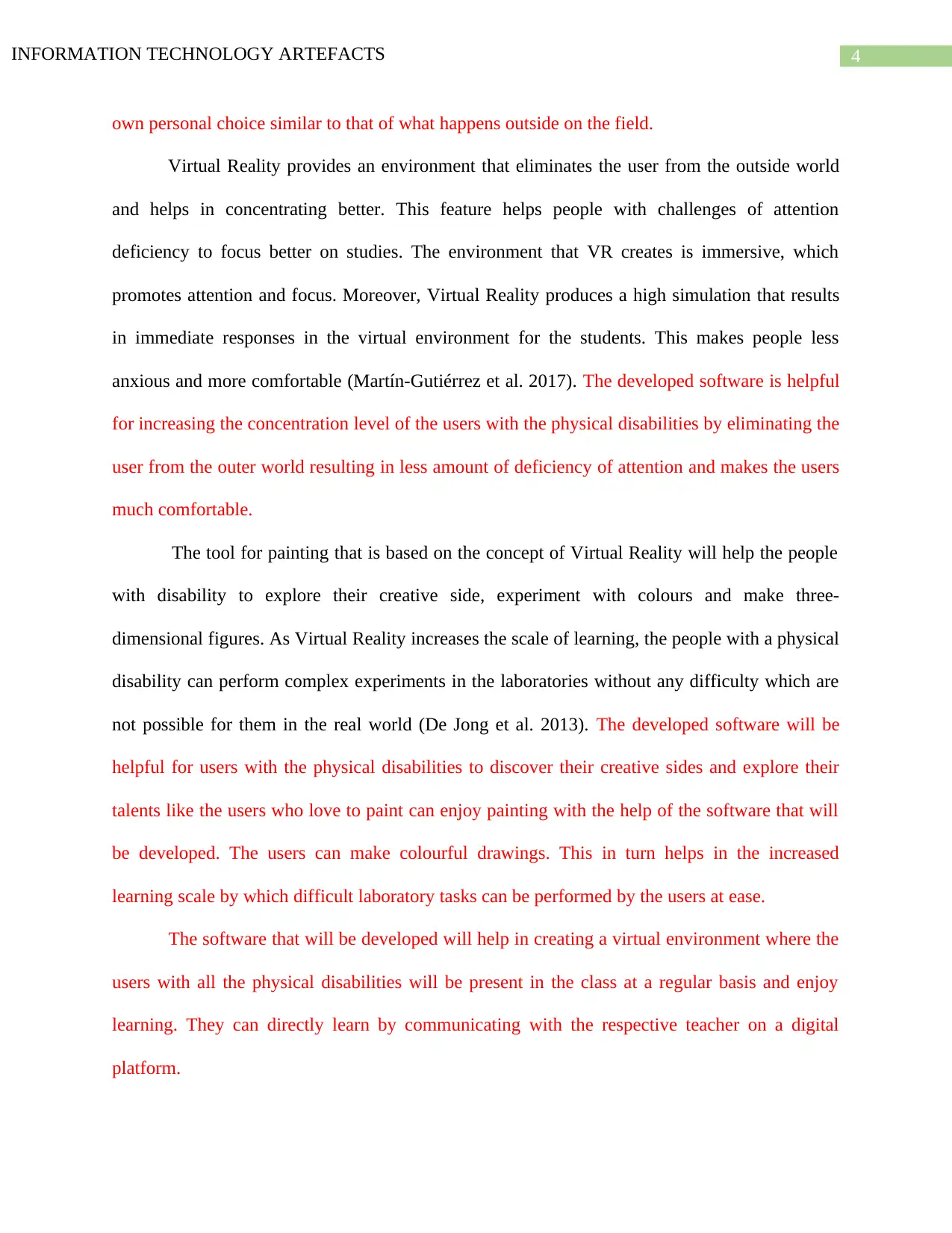
4INFORMATION TECHNOLOGY ARTEFACTS
own personal choice similar to that of what happens outside on the field.
Virtual Reality provides an environment that eliminates the user from the outside world
and helps in concentrating better. This feature helps people with challenges of attention
deficiency to focus better on studies. The environment that VR creates is immersive, which
promotes attention and focus. Moreover, Virtual Reality produces a high simulation that results
in immediate responses in the virtual environment for the students. This makes people less
anxious and more comfortable (Martín-Gutiérrez et al. 2017). The developed software is helpful
for increasing the concentration level of the users with the physical disabilities by eliminating the
user from the outer world resulting in less amount of deficiency of attention and makes the users
much comfortable.
The tool for painting that is based on the concept of Virtual Reality will help the people
with disability to explore their creative side, experiment with colours and make three-
dimensional figures. As Virtual Reality increases the scale of learning, the people with a physical
disability can perform complex experiments in the laboratories without any difficulty which are
not possible for them in the real world (De Jong et al. 2013). The developed software will be
helpful for users with the physical disabilities to discover their creative sides and explore their
talents like the users who love to paint can enjoy painting with the help of the software that will
be developed. The users can make colourful drawings. This in turn helps in the increased
learning scale by which difficult laboratory tasks can be performed by the users at ease.
The software that will be developed will help in creating a virtual environment where the
users with all the physical disabilities will be present in the class at a regular basis and enjoy
learning. They can directly learn by communicating with the respective teacher on a digital
platform.
own personal choice similar to that of what happens outside on the field.
Virtual Reality provides an environment that eliminates the user from the outside world
and helps in concentrating better. This feature helps people with challenges of attention
deficiency to focus better on studies. The environment that VR creates is immersive, which
promotes attention and focus. Moreover, Virtual Reality produces a high simulation that results
in immediate responses in the virtual environment for the students. This makes people less
anxious and more comfortable (Martín-Gutiérrez et al. 2017). The developed software is helpful
for increasing the concentration level of the users with the physical disabilities by eliminating the
user from the outer world resulting in less amount of deficiency of attention and makes the users
much comfortable.
The tool for painting that is based on the concept of Virtual Reality will help the people
with disability to explore their creative side, experiment with colours and make three-
dimensional figures. As Virtual Reality increases the scale of learning, the people with a physical
disability can perform complex experiments in the laboratories without any difficulty which are
not possible for them in the real world (De Jong et al. 2013). The developed software will be
helpful for users with the physical disabilities to discover their creative sides and explore their
talents like the users who love to paint can enjoy painting with the help of the software that will
be developed. The users can make colourful drawings. This in turn helps in the increased
learning scale by which difficult laboratory tasks can be performed by the users at ease.
The software that will be developed will help in creating a virtual environment where the
users with all the physical disabilities will be present in the class at a regular basis and enjoy
learning. They can directly learn by communicating with the respective teacher on a digital
platform.
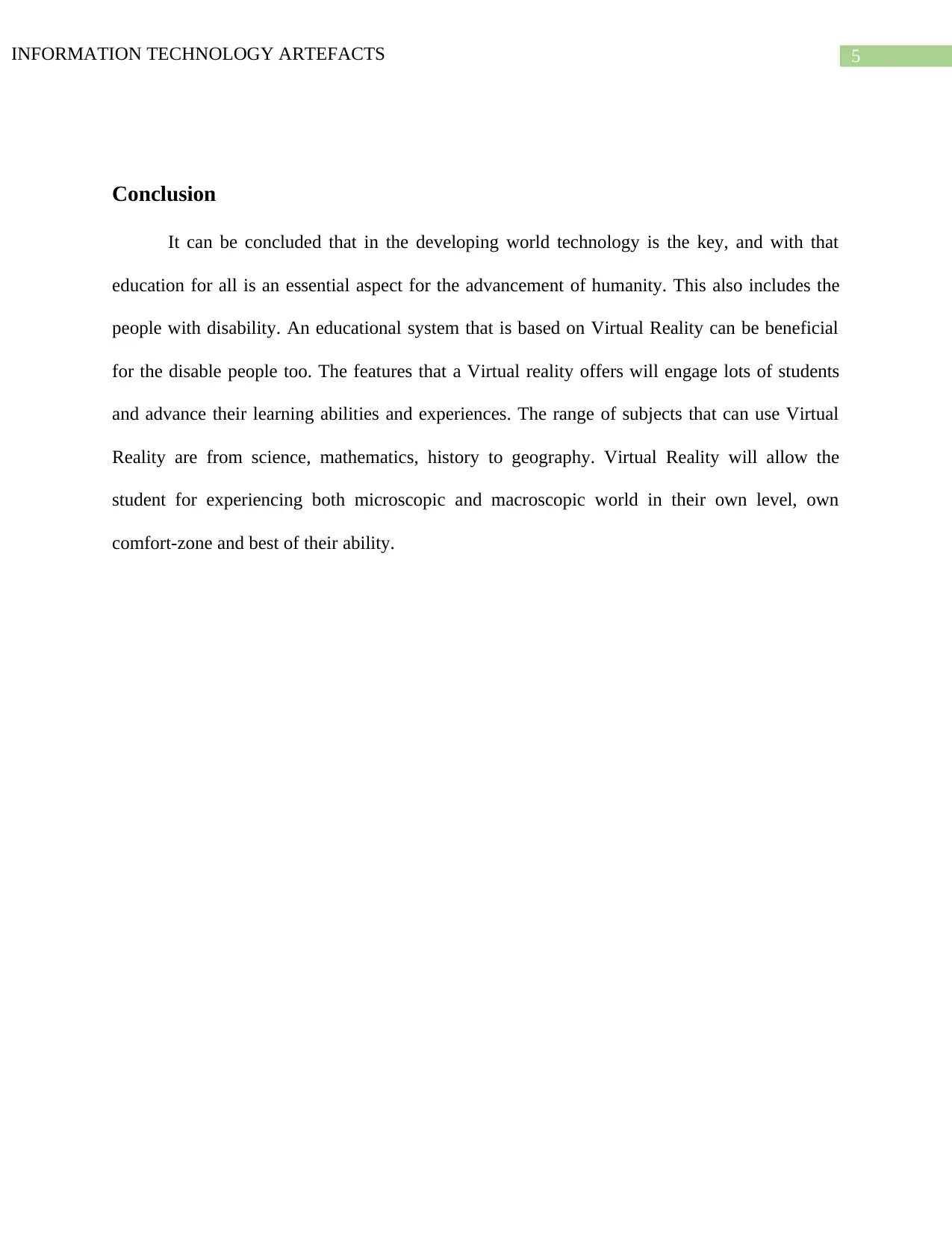
5INFORMATION TECHNOLOGY ARTEFACTS
Conclusion
It can be concluded that in the developing world technology is the key, and with that
education for all is an essential aspect for the advancement of humanity. This also includes the
people with disability. An educational system that is based on Virtual Reality can be beneficial
for the disable people too. The features that a Virtual reality offers will engage lots of students
and advance their learning abilities and experiences. The range of subjects that can use Virtual
Reality are from science, mathematics, history to geography. Virtual Reality will allow the
student for experiencing both microscopic and macroscopic world in their own level, own
comfort-zone and best of their ability.
Conclusion
It can be concluded that in the developing world technology is the key, and with that
education for all is an essential aspect for the advancement of humanity. This also includes the
people with disability. An educational system that is based on Virtual Reality can be beneficial
for the disable people too. The features that a Virtual reality offers will engage lots of students
and advance their learning abilities and experiences. The range of subjects that can use Virtual
Reality are from science, mathematics, history to geography. Virtual Reality will allow the
student for experiencing both microscopic and macroscopic world in their own level, own
comfort-zone and best of their ability.
⊘ This is a preview!⊘
Do you want full access?
Subscribe today to unlock all pages.

Trusted by 1+ million students worldwide
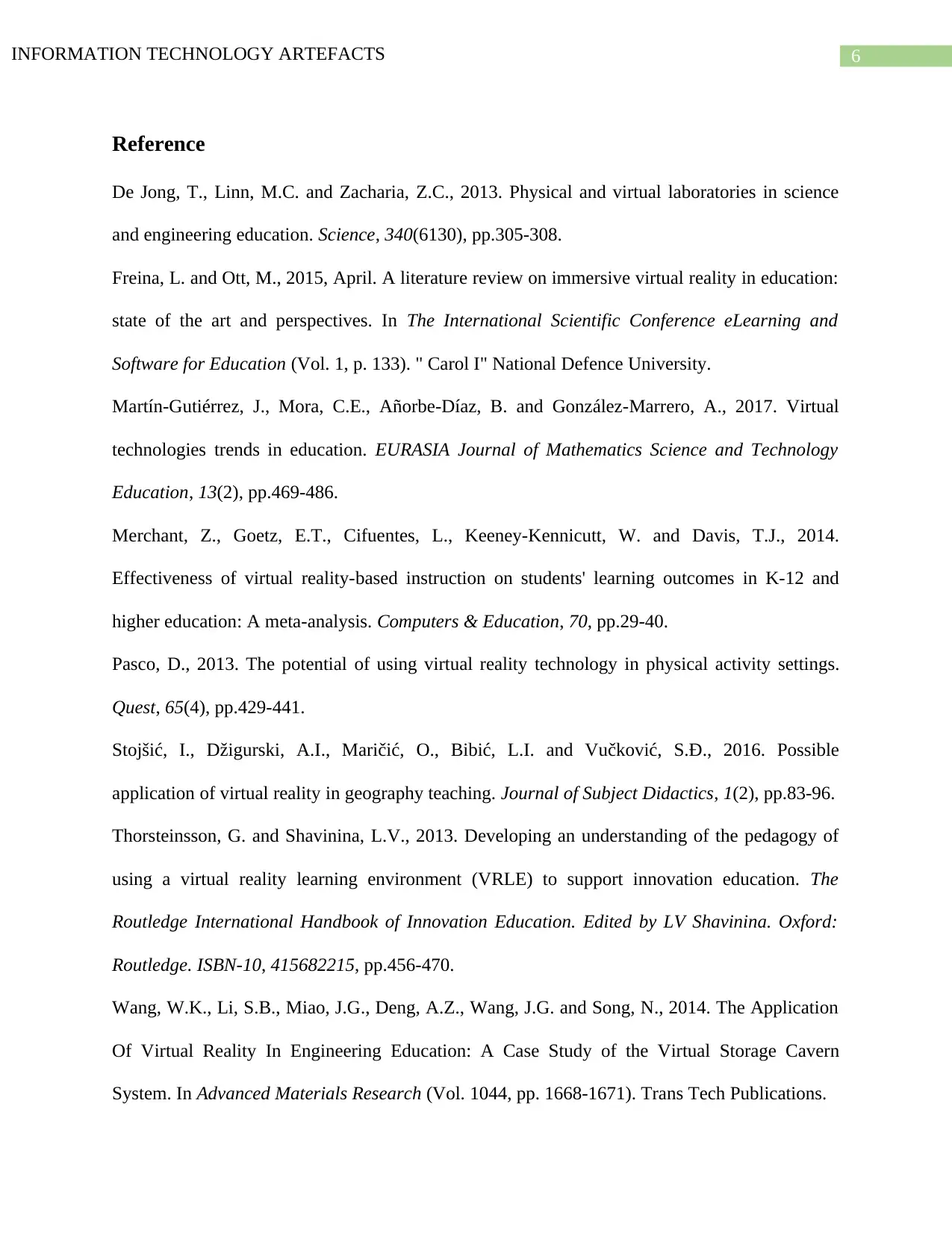
6INFORMATION TECHNOLOGY ARTEFACTS
Reference
De Jong, T., Linn, M.C. and Zacharia, Z.C., 2013. Physical and virtual laboratories in science
and engineering education. Science, 340(6130), pp.305-308.
Freina, L. and Ott, M., 2015, April. A literature review on immersive virtual reality in education:
state of the art and perspectives. In The International Scientific Conference eLearning and
Software for Education (Vol. 1, p. 133). " Carol I" National Defence University.
Martín-Gutiérrez, J., Mora, C.E., Añorbe-Díaz, B. and González-Marrero, A., 2017. Virtual
technologies trends in education. EURASIA Journal of Mathematics Science and Technology
Education, 13(2), pp.469-486.
Merchant, Z., Goetz, E.T., Cifuentes, L., Keeney-Kennicutt, W. and Davis, T.J., 2014.
Effectiveness of virtual reality-based instruction on students' learning outcomes in K-12 and
higher education: A meta-analysis. Computers & Education, 70, pp.29-40.
Pasco, D., 2013. The potential of using virtual reality technology in physical activity settings.
Quest, 65(4), pp.429-441.
Stojšić, I., Džigurski, A.I., Maričić, O., Bibić, L.I. and Vučković, S.Đ., 2016. Possible
application of virtual reality in geography teaching. Journal of Subject Didactics, 1(2), pp.83-96.
Thorsteinsson, G. and Shavinina, L.V., 2013. Developing an understanding of the pedagogy of
using a virtual reality learning environment (VRLE) to support innovation education. The
Routledge International Handbook of Innovation Education. Edited by LV Shavinina. Oxford:
Routledge. ISBN-10, 415682215, pp.456-470.
Wang, W.K., Li, S.B., Miao, J.G., Deng, A.Z., Wang, J.G. and Song, N., 2014. The Application
Of Virtual Reality In Engineering Education: A Case Study of the Virtual Storage Cavern
System. In Advanced Materials Research (Vol. 1044, pp. 1668-1671). Trans Tech Publications.
Reference
De Jong, T., Linn, M.C. and Zacharia, Z.C., 2013. Physical and virtual laboratories in science
and engineering education. Science, 340(6130), pp.305-308.
Freina, L. and Ott, M., 2015, April. A literature review on immersive virtual reality in education:
state of the art and perspectives. In The International Scientific Conference eLearning and
Software for Education (Vol. 1, p. 133). " Carol I" National Defence University.
Martín-Gutiérrez, J., Mora, C.E., Añorbe-Díaz, B. and González-Marrero, A., 2017. Virtual
technologies trends in education. EURASIA Journal of Mathematics Science and Technology
Education, 13(2), pp.469-486.
Merchant, Z., Goetz, E.T., Cifuentes, L., Keeney-Kennicutt, W. and Davis, T.J., 2014.
Effectiveness of virtual reality-based instruction on students' learning outcomes in K-12 and
higher education: A meta-analysis. Computers & Education, 70, pp.29-40.
Pasco, D., 2013. The potential of using virtual reality technology in physical activity settings.
Quest, 65(4), pp.429-441.
Stojšić, I., Džigurski, A.I., Maričić, O., Bibić, L.I. and Vučković, S.Đ., 2016. Possible
application of virtual reality in geography teaching. Journal of Subject Didactics, 1(2), pp.83-96.
Thorsteinsson, G. and Shavinina, L.V., 2013. Developing an understanding of the pedagogy of
using a virtual reality learning environment (VRLE) to support innovation education. The
Routledge International Handbook of Innovation Education. Edited by LV Shavinina. Oxford:
Routledge. ISBN-10, 415682215, pp.456-470.
Wang, W.K., Li, S.B., Miao, J.G., Deng, A.Z., Wang, J.G. and Song, N., 2014. The Application
Of Virtual Reality In Engineering Education: A Case Study of the Virtual Storage Cavern
System. In Advanced Materials Research (Vol. 1044, pp. 1668-1671). Trans Tech Publications.
1 out of 7
Related Documents
Your All-in-One AI-Powered Toolkit for Academic Success.
+13062052269
info@desklib.com
Available 24*7 on WhatsApp / Email
![[object Object]](/_next/static/media/star-bottom.7253800d.svg)
Unlock your academic potential
Copyright © 2020–2025 A2Z Services. All Rights Reserved. Developed and managed by ZUCOL.




